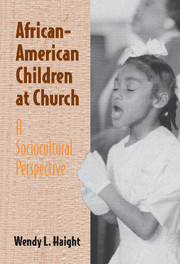Book contents
- Frontmatter
- Contents
- List of Tables
- Acknowledgments
- PART ONE OVERVIEW
- 1 Introduction
- 2 The African-American Church and the Socialization of Children's Resiliency
- 3 Research Strategy
- PART TWO PATTERNS OF SOCIALIZATION AND PARTICIPATION
- PART THREE RELATIONSHIPS OF RESEARCH AND PRACTICE
- PART FOUR CONCLUSION
- References
- Index
2 - The African-American Church and the Socialization of Children's Resiliency
Published online by Cambridge University Press: 10 August 2009
- Frontmatter
- Contents
- List of Tables
- Acknowledgments
- PART ONE OVERVIEW
- 1 Introduction
- 2 The African-American Church and the Socialization of Children's Resiliency
- 3 Research Strategy
- PART TWO PATTERNS OF SOCIALIZATION AND PARTICIPATION
- PART THREE RELATIONSHIPS OF RESEARCH AND PRACTICE
- PART FOUR CONCLUSION
- References
- Index
Summary
In the following narrative fragment, Sister Justine and her class of 8- to 12-year-old students grapple with the complex question: What is the church?
sj: Do you see what this lesson [Ephesians 4: 1–16] is all about? … The church is, is not just a building. What the church is, is not just comin' and putting in your money and sittin' in and listening to the choir. The church is the whole people. The church is us.
tranese: Everybody.
sj: The community. This is us. … How do you think Jesus wants this church to work? … He wants all of us to do something! We're not just supposed to come into this church and sit down! And just lo – ok! He wants us to do something. He gave us … gifts! … We all have certain gifts – and we're supposed to find out what they are … [What are we] supposed to use them for …
javarius: [to] build the church.
sj: [to] build the church! This boy is sha–rp! He's o–n it.
Sister Justine and the children define the church as a living community, as “us.” Within this community, children are valued as resources and opportunities are created for their increasing participation. Every individual is treasured, everyone has gifts, and everyone has a responsibility to use those gifts for the common good.
- Type
- Chapter
- Information
- African-American Children at ChurchA Sociocultural Perspective, pp. 19 - 31Publisher: Cambridge University PressPrint publication year: 2001



